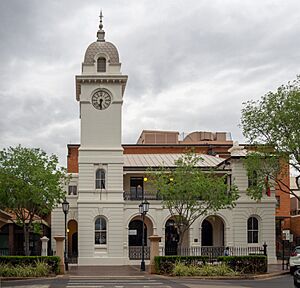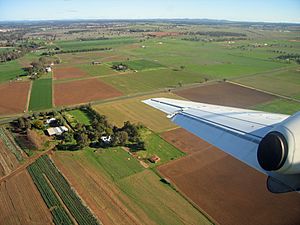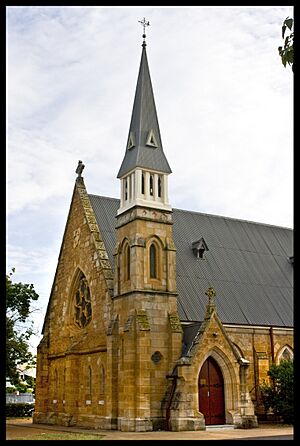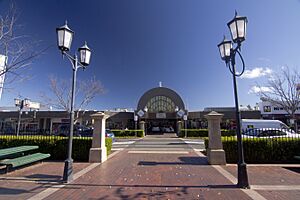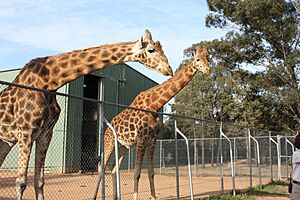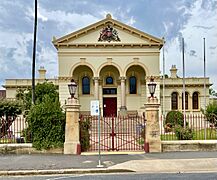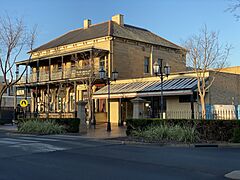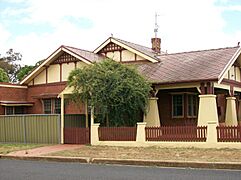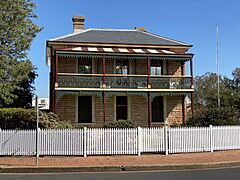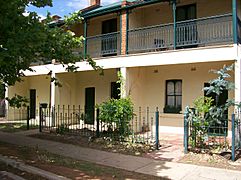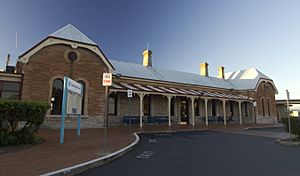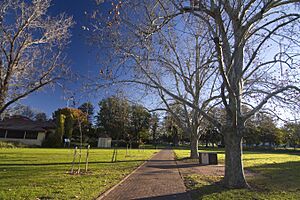Dubbo facts for kids
Quick facts for kids DubboNew South Wales |
|||||||||
|---|---|---|---|---|---|---|---|---|---|
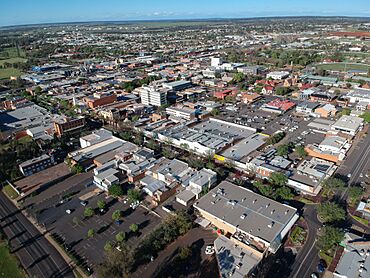
Dubbo town centre from above, 2020
|
|||||||||
| Population | 43,516 (2021) (37) | ||||||||
| • Density | 238.31/km2 (617.2/sq mi) | ||||||||
| Established | 1849 1966 (city) |
||||||||
| Postcode(s) | 2830 | ||||||||
| Elevation | 275 m (902 ft) | ||||||||
| Area | 182.6 km2 (70.5 sq mi) | ||||||||
| Time zone | AEST (UTC+10) | ||||||||
| • Summer (DST) | AEDT (UTC+11) | ||||||||
| Location | |||||||||
| LGA(s) | Dubbo Regional Council | ||||||||
| Region | Central West / Orana | ||||||||
| County | Gordon | ||||||||
| State electorate(s) | Dubbo | ||||||||
| Federal Division(s) | Parkes | ||||||||
|
|||||||||
Dubbo (/ˈdʌboʊ/; Wiradjuri: Dhubu) is a city in the Orana Region of New South Wales, Australia. It's the biggest city in the Orana region, with about 43,516 people living there in June 2021.
Dubbo is located where the Newell, Mitchell, and Golden highways meet. It became an official city in 1966. Dubbo is about 275 metres (902 feet) above sea level. It's about 303 kilometres (188 miles) north-west of Sydney (or 400 kilometres/249 miles by road). It's a major hub for road and rail transport to other parts of New South Wales.
The city is connected by national highways. You can travel north to Brisbane, south to Melbourne and Canberra, east to Sydney, and west to Broken Hill. Dubbo is also part of the weather forecast region for the Central West Slopes.
Contents
History
People from the Wiradjuri tribe, who are Indigenous Australians, lived in this area over 40,000 years ago.
The first European to explore and report on the Dubbo area was John Oxley in 1818. The first British settlers to stay in the area were brothers Robert and Lawrence Dulhunty.
Robert Dulhunty started a property called Dubbo Station around the early 1830s. He didn't own the land at first, but later got a licence for it in 1836.
Dulhunty got along well with the local Aboriginal people. His group included about 40 Aboriginal people, and he liked to use Aboriginal names for properties, including Dubbo. The name "Dubbo" is thought to be a slightly changed version of the local Wiradjuri word thubbo. We don't have exact records from Dulhunty, and we don't fully know the Wiradjuri language today. So, the exact meaning of the word is still a bit of a mystery. Some say Dubbo was the name of an old Wiradjuri man who lived there. Others think it meant "red soil," which fits the area. Thubbo or tubbo might also mean "head covering."
Dundullimal Homestead is an old farmhouse from that time. It was built around 1840 by John Maugham on his large sheep farm. This building is one of the oldest farmhouses still standing in western New South Wales. Today, you can visit it.
By 1846, many settlers were in the area. So, the government decided to build a courthouse, police station, and jail in Dubbo. A police officer's home was finished in 1847. A wooden courthouse and jail were ready in early 1848. At this time, the settlement only had four buildings: the police home, the courthouse and jail, a shop, and an inn.
Because people didn't officially own their land, a shopkeeper named Jean Emile Serisier asked the government to sell land plots in 1848. The town was officially named a village in November 1849. The first land sales happened in 1850. The town grew slowly until the Victorian gold rush in the 1860s. This brought more trade between the north and south. The first bank opened in 1867.
Dubbo became a municipality (a town with its own local government) in 1872, when it had 850 people. The railway line from Wellington reached Dubbo on 1 February 1881. By 1897, Dubbo had a general store, a hotel, a courthouse, a jail, and a police hut. The last part of the railway to Dubbo opened in May 1925. Dubbo officially became a city in 1966.
On 10 June 1989, a famous train called the Flying Scotsman (along with another train, the 3801) finished a long journey in Dubbo. It was the last stop for the "Through West Mail" train.
Heritage Listings
Dubbo has many places that are important for their history. These are called heritage-listed sites. Some of them include:
- Cobra Street: Dubbo RAAF Stores Depot
- Macquarie Street: Talbragar Shire Council Chambers
- 110–114 Macquarie Street: National Australia Bank building, Dubbo
- 118 Macquarie Street: Colonial Mutual Life building, Dubbo
- 195–197 Macquarie Street: Milestone Hotel
- 215 Macquarie Street: Old Dubbo Gaol
- Main Western railway: Dubbo railway station
- Main Western railway 462.762 km: Macquarie River railway bridge, Dubbo
- Obley Road: Dundullimal Homestead
Geography
The Macquarie River and Troy Creek flow through Dubbo. The city is located where the mountains and high lands of the Great Dividing Range meet the flat plains to the west.
Climate
Dubbo has a warm temperate climate. This means summers are warm to hot, and winters are cool to cold. You might see some frost in the early mornings during winter, but usually no snow. The last time snow was recorded was in July 1951 and 1920. Because Dubbo is in a "transition area," the temperature can change a lot throughout the year. Summers can be very hot, sometimes over 40°C (104°F). Winters can be very cold, with temperatures below freezing.
Dubbo gets a good amount of rain spread out through the year. January is usually the wettest month. Dubbo is also very sunny, with about 148 clear days each year.
The wind in Dubbo mostly blows from the southeast, south, southwest, and west.
| Climate data for Dubbo Airport AWS (1993–2022); 284 m AMSL; 32.22° S, 148.58° E | |||||||||||||
|---|---|---|---|---|---|---|---|---|---|---|---|---|---|
| Month | Jan | Feb | Mar | Apr | May | Jun | Jul | Aug | Sep | Oct | Nov | Dec | Year |
| Record high °C (°F) | 45.0 (113.0) |
46.1 (115.0) |
39.5 (103.1) |
34.4 (93.9) |
28.6 (83.5) |
24.1 (75.4) |
24.0 (75.2) |
28.3 (82.9) |
35.5 (95.9) |
38.1 (100.6) |
44.3 (111.7) |
44.9 (112.8) |
46.1 (115.0) |
| Mean daily maximum °C (°F) | 33.6 (92.5) |
32.0 (89.6) |
29.0 (84.2) |
24.9 (76.8) |
20.1 (68.2) |
16.4 (61.5) |
15.6 (60.1) |
17.6 (63.7) |
21.4 (70.5) |
25.2 (77.4) |
28.7 (83.7) |
31.5 (88.7) |
24.7 (76.4) |
| Mean daily minimum °C (°F) | 18.4 (65.1) |
17.6 (63.7) |
14.8 (58.6) |
10.3 (50.5) |
6.5 (43.7) |
4.4 (39.9) |
3.0 (37.4) |
3.2 (37.8) |
6.0 (42.8) |
9.5 (49.1) |
13.5 (56.3) |
16.0 (60.8) |
10.3 (50.5) |
| Record low °C (°F) | 5.8 (42.4) |
6.3 (43.3) |
3.4 (38.1) |
−2.2 (28.0) |
−4.0 (24.8) |
−4.9 (23.2) |
−6.0 (21.2) |
−4.9 (23.2) |
−3.2 (26.2) |
−0.4 (31.3) |
2.0 (35.6) |
4.5 (40.1) |
−6.0 (21.2) |
| Average precipitation mm (inches) | 58.7 (2.31) |
45.0 (1.77) |
68.0 (2.68) |
36.4 (1.43) |
38.1 (1.50) |
49.9 (1.96) |
43.3 (1.70) |
34.3 (1.35) |
41.5 (1.63) |
45.8 (1.80) |
61.8 (2.43) |
61.7 (2.43) |
584.5 (22.99) |
| Average precipitation days (≥ 1.0 mm) | 5.3 | 4.8 | 5.2 | 3.1 | 4.1 | 5.6 | 5.3 | 4.3 | 4.9 | 5.2 | 5.7 | 4.9 | 58.4 |
| Average afternoon relative humidity (%) | 32 | 36 | 36 | 37 | 47 | 57 | 55 | 47 | 43 | 36 | 35 | 30 | 41 |
| Average dew point °C (°F) | 11.2 (52.2) |
11.8 (53.2) |
9.7 (49.5) |
7.0 (44.6) |
6.7 (44.1) |
6.6 (43.9) |
5.0 (41.0) |
4.3 (39.7) |
5.5 (41.9) |
5.3 (41.5) |
8.0 (46.4) |
8.3 (46.9) |
7.4 (45.3) |
| Source: Australian Bureau of Meteorology (Dubbo Airport AWS, 1993–2022) | |||||||||||||
People of Dubbo
| Historical population | ||
|---|---|---|
| Year | Pop. | ±% |
| 1921 | 5,032 | — |
| 1933 | 8,344 | +65.8% |
| 1947 | 9,686 | +16.1% |
| 1954 | 12,009 | +24.0% |
| 1961 | 14,118 | +17.6% |
| 1966 | 15,629 | +10.7% |
| 1971 | 17,810 | +14.0% |
| 1976 | 20,149 | +13.1% |
| 1981 | 23,986 | +19.0% |
| 1986 | 25,796 | +7.5% |
| 1991 | 28,064 | +8.8% |
| 1996 | 30,102 | +7.3% |
| 2001 | 30,860 | +2.5% |
| 2006 | 30,574 | −0.9% |
| 2011 | 32,327 | +5.7% |
| 2016 | 34,339 | +6.2% |
| 2021 | 38,783 | +12.9% |
| Source: Australian Bureau of Statistics data. | ||
In August 2021, Dubbo had 43,516 people. A little more than half were female (51.6%), and a little less than half were male (48.4%). The average age was 35, which is a bit younger than the average for all of Australia (38). Kids aged 0–14 made up 21.5% of the population. About 15.6% of residents were Aboriginal or Torres Strait Islander people. Their average age was 22.
Most people (81.2%) in Dubbo were born in Australia. This is higher than the national average (66.9%). Other common birthplaces include India (1.7%), Nepal (1.6%), England (1.0%), the Philippines (0.8%), and New Zealand (0.7%). The most common family backgrounds reported in Dubbo are Australian, English, Australian Aboriginal, Irish, and Scottish.
About 82.7% of people in Dubbo speak only English at home. Other languages spoken include Nepali (1.7%), Punjabi (0.8%), and Malayalam (0.5%).
The main religious groups in Dubbo are Catholic (26.4%), Anglican (17.7%), and Uniting Church (3.7%). About 27.2% of people said they had no religion.
Economy
Dubbo's biggest private employer is Fletcher International Exports. This company sends lamb and mutton meat all over the world. Other local businesses support the farms and agriculture in the areas around Dubbo.
The Dubbo Base Hospital is also a very large employer. Hospitals are the biggest single employer in the area.
Shopping
Dubbo is a major shopping centre for many towns in the Central and Far Western parts of New South Wales. Dubbo has many shopping areas. These include the large and recently updated Orana Mall, the city centre streets (Macquarie and Talbragar Streets), Centro Dubbo, Riverdale, and local shops on Tamworth Street. You can find unique stores and big national shops in Dubbo.
There's also a new shopping centre in West Dubbo with a supermarket and 15 smaller shops.
Tourism
Tourism is a very important business in Dubbo. A popular place to visit is the Taronga Western Plains Zoo. It's an open-range zoo, meaning animals have lots of space. It's home to many endangered animals, like white, black, and Indian rhinoceroses. The zoo also has successful programs to help these endangered species have babies. Animals from all over the world live in large, open areas, grouped by where they come from.
Other fun places to visit in Dubbo include the historic Dundullimal Homestead and the Old Dubbo Gaol (an old jail) right in the city centre. The Western Plains Cultural Centre has art galleries, museum exhibits, and a community arts centre.
The Royal Flying Doctor Service has a base at the Dubbo airport. They have a big visitor centre there, run by volunteers. You can see a real plane and use touch-screen displays to learn about how the Flying Doctor Service helps people in remote areas.
Education
Dubbo has 20 schools and colleges. This includes the Dubbo School of Distance Education, where students learn from home. Dubbo is also home to one of the main campuses of Charles Sturt University. This university campus is next to the Senior Campus of Dubbo College, which used to be Dubbo High School (founded in 1917). There are three private schools in Dubbo for all ages (Kindergarten to Year 12): Macquarie Anglican Grammar School, Dubbo Christian School, and St Johns College.
Architecture
Dubbo has some beautiful old buildings from the Victorian era. These include the Courthouse (built in 1887) and the Lands Office, which uses timber and corrugated iron. In the older parts of the city, you can see many red brick houses built in the "California Bungalow" style from the early 1900s. There are also Victorian terraced houses and some Edwardian homes.
Transport
Dubbo railway station is on the main railway line that goes between Sydney and Bourke. It opened in 1881. The station is the end point for the daily Central West XPT train service from Sydney. From Dubbo, you can catch connecting buses to places like Broken Hill, Bourke, and Tamworth. A new train maintenance centre, the Mindyarra Maintenance Centre, is planned to open near the station.
Dubbo Buslines runs bus services within the city. BusBiz also runs coach services that connect Dubbo to other towns.
Dubbo City Regional Airport has flights to Sydney (QantasLink, Regional Express), Newcastle (FlyPelican), Canberra (FlyPelican), and other smaller towns in New South Wales (Airlink).
Media

Here are some of the local newspapers in Dubbo:
- The Daily Liberal
- The Weekly Dubbo Photo News
- The Weekly Mailbox Shopper
Three commercial radio stations broadcast in the city:
- Triple M on FM 93.5, playing rock music.
- 2DU – an older local station on AM 1251.
- Zoo FM – a rock music station on FM 92.7.
ABC Radio also has a studio in Dubbo called ABC Western Plains. It broadcasts local news and talk on 95.9FM.
ABC Radio also offers five other services in the Dubbo area: ABC Local, ABC Radio National, Triple J, ABC Classic FM, and ABC NewsRadio.
Dubbo also has other radio stations, including Racing Radio (90.3 FM), a tourist radio station, and a country music station. There are two community radio stations: DCFM 88.9 Dubbo Community radio, and Rhema FM, which plays Christian music.
The Dubbo area gets five main television stations. All Australian TV stations now broadcast digital signals. The main channels are:
- Seven (used to be Prime7) – connected to the Seven Network.
- 10 Regional – connected to Network 10.
- WIN Television's Nine – connected to the Nine Network.
- ABC TV – the national public broadcaster.
- SBS Television – another national public broadcaster.
Both Seven and WIN Television make local news shows that are half an hour long. Seven News is on at 6 pm, and WIN News is on at 5:30 pm from Monday to Friday.
You can also get Subscription Television services like Foxtel in Dubbo.
Sport and Recreation
Sports are a big part of life in Dubbo. Rugby league is very popular. Two teams, the Dubbo CYMS and Dubbo Macquarie Raiders, play in the Group 11 Rugby League. The city also has an Australian rules football team, the Dubbo Demons. They won the Central West Australian Football League in 2007.
There are two rugby union teams: the Dubbo Kangaroos (Roos) and the Dubbo Rhinos. They play in the Blowes Clothing Cup competition.
The Dubbo Junior Cricket Association organises cricket for over 500 children aged 5 to 16. They also have competitions for older players.
Dubbo has a turf club for pony club and horse racing. They also organise shows and gymkhana events. Ultimate Frisbee is a newer sport that is becoming very popular.
The Dubbo Ultimate Frisbee Federation (DUFF) is the local club. They organise a local league and a representative team called the Dubbo Meerkats Mixed. The Dubbo Rams play in the men's and women's NSW State Basketball Leagues. Netball is also popular in Dubbo, with games every weekend during the netball season at the Nita McGrath netball courts. Dubbo has a large Junior and Senior Hockey Association. They have teams that play in the Premier League Hockey Competition. Soccer is very popular, especially with kids. Dubbo has its own men's and women's soccer competitions. Three teams – Dubbo FC Bulls, Westside Panthers, and Orana Spurs – play in the Western Premier League.
Dubbo also has one of the only 10-lane swimming pools outside of Sydney in New South Wales. It's called the Dubbo Aquatic and Leisure Centre. This centre hosts swimming competitions and school carnivals.
Caltex Park in Dubbo has hosted big rugby league matches, including the annual City vs Country Origin game in 2006 and 2014.
In 2007, Dubbo hosted the Junior World Orienteering Championships. Most of these events took place in the rocky areas of the nearby Sappa Bulga Range. After this event, the Western Plains Orienteers club was started. Other popular sports in Dubbo include lawn bowls and golf (on Dubbo's 27-hole golf course).
In 2022, Dubbo hosted the NSWPSSA Boys Cricket State Championships. The games were played in Victoria Park and Lady Cuttler Fields.
The Tracker Riley bike path is named after a famous blacktracker (an Aboriginal person skilled in tracking). It's part of a 12.5-kilometre (7.8-mile) walking and cycling loop along the Macquarie River.
Famous People from Dubbo
Many notable people have connections to Dubbo. Here are a few:
- Kirsty Lee Allan – an actress from the TV show Sea Patrol.
- Matt Burton – a rugby league player for the Canterbury Bulldogs.
- Megan Dunn – a cyclist who won two gold medals at the 2010 Delhi Commonwealth Games.
- William Ferguson – an Aboriginal leader who helped organise the 1938 Day of Mourning protest.
- Lizzy Gardiner – a costume designer.
- Glenn McGrath – a famous Australian international cricketer.
- Steve Peacocke – an actor known for his role in the TV show Home and Away.
- Andrew Ryan – a former NRL player.
- Jean Emile Serisier – Dubbo's first businessman.
- Ashleigh Sykes – an Australian international soccer player.
- Thirsty Merc – a popular Australian rock band.
- Barrie Unsworth – a former Premier of New South Wales.
- Isaah Yeo – a rugby league player and co-captain of the Penrith Panthers.
See also
 In Spanish: Dubbo para niños
In Spanish: Dubbo para niños



